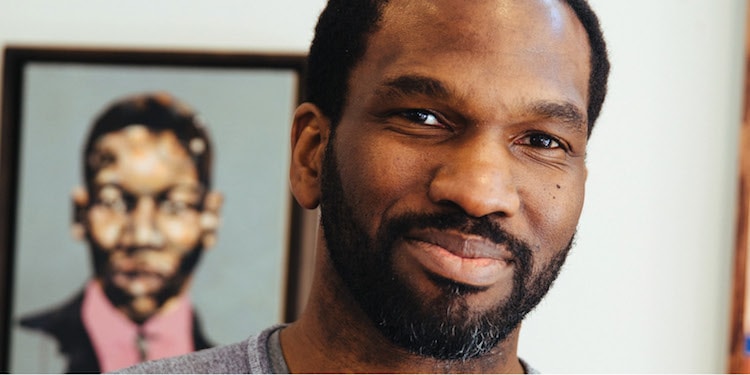
Jeremy Okai Davis is a Portland painter, partner to Brittany and dad of two boys, Runey (2) and Rhye (almost brand-new). He grew up in Charlotte, North Carolina, in a tight-knit family and describes his parents and siblings as his biggest cheerleaders, but moved here in 2007 for the artistic diversity. You may have seen him on OPB’s Oregon Art Beat, which highlighted his gallery shows The Presence of Color and Black Wood.
When you paint white skin, it’s not white at all — and Black skin isn’t black. They’re both all these patches of color. Is that mostly about realism and depicting how skin actually looks, or is it a statement about how absurd it is to call anyone “white” or “black”?
When I developed this style and technique, I was thinking of digitized images and how pixels break down and create a range of colors up close. I was essentially painting pixels. I’ve always been a big fan of Chuck Close and his approach to portraiture. With other people’s art, I love getting really close to it and seeing what makes the image; the way I paint invites that investigation, but also stepping back and taking in what those small elements turn into. Those painted pixels and elements have now taken on new importance in showing how unified we all are in what makes us who we are.
When did you find out about Portland’s racial history?
It was gradual — around 2013 I met Intisar Abioto, who was doing a project called Black Portlanders. And in 2009 someone told me about the Vanport flood. I’m not making work necessarily about Portland. But the cultural climate, the previous president, the killings of unarmed Black people — when Trump was elected, I started making art about being a Black man.
When I look at your work on race, I feel invited in despite my privilege and ignorance as a white person. Is that on purpose?
My own ignorance is on full display a lot of the time when it comes to the plight of African American people, so me looking down at anyone else would be counterproductive. I do have a Black father and my mom is from Liberia. But I didn’t learn a lot in school about African American history, and I didn’t see myself in history books, and we didn’t watch videos about people that look like me — it just seemed like everybody who did amazing things didn’t look like you. It would be crazy for me to point fingers when I have so much to learn about my culture. My work is not a lecture; we’re trying to have a conversation and figure it out together.
How has becoming a dad changed how you work?
Once Runey got old enough and I was able to get back into the studio and work, the act of painting didn’t change a ton; the content more so — it coincided with everything going on in the world and I think I was a little more affected by having a young son to raise. I want to make sure the work he’s seeing represents him. In my work and in things I show him. The second one — Rhye — we’re pretty fresh in. I haven’t figured out how that’s going to change my studio practice other than that it’s getting harder to get into the studio for a little while.
Is there anything you want to say to parents in Portland?
I think one of the greatest gifts a parent can give to their kid is to show them different cultures, and I think art is one of the best vehicles for showing off culture. Take your kids to art galleries. I’m a new parent, so for me to be preachy about it would be crazy. But I wish I had been exposed to that when I was younger. African Americans are in the minority in Portland, but there are a lot of Black and Brown artists making incredible stuff, and it’s not hard to find.
Interview by Stephanie Gehring
- Summer Camps with Space - April 16, 2024
- Portland Half-Day Summer Camps - April 16, 2024
- Summer Camps with Space - April 15, 2024




